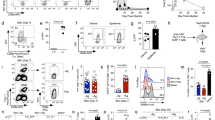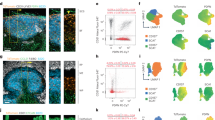Abstract
Secondary lymphoid organs (spleen, lymph nodes and Peyer's patches) are divided into compartments, such as B-cell zones (follicles) and T-cell zones, which provide specialized environments for specific steps of the immune response. Migration of lymphocyte subsets into these compartments is essential for normal immune function, yet the molecular cues guiding this cellular traffic are poorly defined. Chemokines constitute a family of chemotactic cytokines that have been shown to direct the migration of leukocytes during inflammation1,2 and which may be involved in the constitutive homing of lymphocytes into follicles and T-cell zones3,4,5,6,7,8. Here we describe a novel chemokine, B-lymphocyte chemoattractant (BLC), that is strongly expressed in the follicles of Peyer's patches, the spleen and lymph nodes. BLC strongly attracts B lymphocytes while promoting migration of only small numbers of T cells and macrophages, and therefore is the first chemokine to be identified that is selective towards B cells. An orphan chemokine receptor, Burkitt's lymphoma receptor 1 (BLR-1), has been found to be required for B-cell migration into lymphoid follicles6. We show that BLC stimulates calcium influx into, and chemotaxis of, cells transfected with BLR-1. Our results indicate that BLC functions as a BLR-1 ligand and may guide B lymphocytes to follicles in secondary lymphoid organs.
This is a preview of subscription content, access via your institution
Access options
Subscribe to this journal
Receive 51 print issues and online access
$199.00 per year
only $3.90 per issue
Buy this article
- Purchase on Springer Link
- Instant access to full article PDF
Prices may be subject to local taxes which are calculated during checkout




Similar content being viewed by others
References
Bacon, K. B. & Schall, T. J. Chemokines as mediators of allergic inflammation. Int. Arch. Allergy Immunol. 109, 97–109 (1996).
Baggiolini, M., Dewald, B. & Moser, B. Human chemokines: an update. Annu. Rev. Immunol. 15, 675–705 (1997).
Cyster, J. G. & Goodnow, C. C. Pertussis toxin inhibits migration of B and T lymphocytes into splenic white pulp cords. J. Exp. Med. 182, 581–586 (1995).
Lyons, A. B. & Parish, C. R. Are murine marginal-zone macrophages the splenic white pulp analog of high endothelial venules? Eur. J. Immunol. 25, 3165–3172 (1995).
Goodnow, C. C. et al. Self-tolerance checkpoints in B lymphocyte development. Adv. Immunol. 59, 279–368 (1995).
Forster, R. et al. Aputative chemokine receptor, BLR1, directs B cell migration to defined lymphoid organs and specific anatomic compartments of the spleen. Cell 87, 1–20 (1996).
Butcher, E. C. & Picker, L. J. Lymphocyte homing and homeostasis. Science 272, 60–66 (1996).
Goodnow, C. C. & Cyster, J. G. Lymphocyte homing: the scent of a follicle. Curr. Biol. 7, R219–R222 (1997).
MacLennan, I. C. M. Germinal centers. Annu. Rev. Immunol. 12, 117–139 (1994).
Yoshida, K., van den Berg, T. K. & Dijkstra, C. D. The functional state of follicular dendritic cells in severe combined immunodeficient (SCID) mice: role of the lymphocytes. Eur. J. Immunol. 24, 464–468 (1994).
Imai, Y. & Yamakawa, M. Morphology, function and pathology of follicular dendritic cells. Pathol. Int. 46, 807–833 (1996).
Schuler, G. et al. Agene map of the human genome. Science 274, 540–546 (1996).
Calnek, B. W. Marek's disease: a model for herpesvirus oncology. CRC Crit. Rev. Microbiol. 12, 293–320 (1986).
Peng, Q. et al. Isolation and characterization of Marek's disease viruse (MDV) cDNAs mapping to the BamHI-I2, BamHI-Q2, and BamHI-L fragments of the MDV genome from lymphoblastoid cells transformed and persistently infected with MDV. Virology 213, 590–599 (1995).
Bleul, C. C., Fuhlbrigge, R. C., Casasnovas, J. M., Aiuti, A. & Springer, T. A. Ahighly efficacious lymphocyte chemoattractant, stromal cell-derived factor 1 (SDF-1). J. Exp. Med. 184, 1101–1109 (1996).
Forster, R., Emrich, T., Kremmer, E. & Lipp, M. Expression of the G-protein-coupled receptor BLR1 defines mature, recirculating B cells and a subset of T-helper memory cells. Blood 84, 830–840 (1994).
Kaiser, E. et al. The G-protein coupled receptor BLR1 is involved in murine B cell differentiation and is also expressed in neuronal tissues. Eur. J. Immunol. 23, 2532–2539 (1993).
Barella, L., Loetscher, M., Tobler, A., Baggiolini, M. & Moser, B. Sequence variation of a novel heptahelical leucocyte receptor through alternative transcript formation. Biochem. J. 309, 773–779 (1995).
Adema, G. J. et al. Adendritic-cell-derived C-C chemokine that preferentially attracts naive T cells. Nature 387, 713–717 (1997).
Nagira, M. et al. Molecular cloning of a novel human CC chemokine secondary lymphoid-tissue chemokine that is a potent chemoattractant for lymphocytes and mapped to chromosome 9p13. J.Biol. Chem. 272, 19518–19524 (1997).
Gunn, M. D. et al. Achemokine expressed in lymphoid high endothelial venules promotes the adhesion and chemotaxis of naive T lymphocytes. Proc. Natl Acad. Sci. USA 95, 258–263 (1998).
Pearson, W. & Lipman, D. Improved tools for biological sequence comparison. Proc. Natl Acad. Sci. USA 85, 2444–2448 (1988).
Altschul, S., Gish, W., Miller, W., Myers, E. & Lipman, D. Basic local alignment search tool. J. Mol. Biol. 215, 403–410 (1990).
Lennon, G., Auffray, C., Polymeropoulos, M. & Soares, M. B. The I.M.A.G.E. Consortium: an integrated molecular analysis of genomes and their expression. Genomics 33, 151–152 (1996).
Ishii, K., Hein, L., Kobilka, B. & Coughlin, S. Kinetics of thrombin receptor cleavage on intact cells. Relation to signaling. J. Biol. Chem. 268, 9780–9786 (1993).
Bleul, C. C. et al. The lymphocyte chemoattractant SDF-1 is a ligand for LESTR/fusion and blocks HIV-1 entry. Nature 382, 829–833 (1996).
Ueda, H. et al. Chemically synthesized SDF-1 alpha analogue, N33A, is a potent chemotactic agent for CXCR4/fusion/LESTR-expressing human leukocytes. J. Biol. Chem. 272, 24966–24970 (1997).
Myers, S. J., Wong, L. M. & Charo, I. F. Signal transduction and ligand specificity of the human monocyte chemoattractant protein-1 receptor in transfected embryonic kidney cells. J. Biol. Chem. 270, 5786–5792 (1995).
Acknowledgements
We thank L. Prentice, C. Tam, D. Milfay, C. Turck and C. Hsu for technical support. and M. Siani and I. Charo for gifts of reagents. J.G.C. is a Pew Scholar in the biomedical sciences. K.M.A. and E.H.E. are supported by HHMI predoctoral fellowships. This work was supported by an unrestricted award from the HHMI to M.D.G. and L.T.W. and by an NIH grant to J.G.C.
Author information
Authors and Affiliations
Corresponding author
Rights and permissions
About this article
Cite this article
Gunn, M., Ngo, V., Ansel, K. et al. A B-cell-homing chemokine made in lymphoid follicles activates Burkitt's lymphoma receptor-1. Nature 391, 799–803 (1998). https://doi.org/10.1038/35876
Received:
Accepted:
Issue Date:
DOI: https://doi.org/10.1038/35876
This article is cited by
-
Cerebrospinal Fluid CXCL13 as Candidate Biomarker of Intrathecal Immune Activation, IgG Synthesis and Neurocognitive Impairment in People with HIV
Journal of Neuroimmune Pharmacology (2023)
-
CXCL13 chemokine is a novel player in multiple myeloma osteolytic microenvironment, M2 macrophage polarization, and tumor progression
Journal of Hematology & Oncology (2022)
-
CXCL13 is expressed in a subpopulation of neuroendocrine cells in the murine trachea and lung
Cell and Tissue Research (2022)
-
Immunogenic necroptosis in the anti-tumor photodynamic action of BAM-SiPc, a silicon(IV) phthalocyanine-based photosensitizer
Cancer Immunology, Immunotherapy (2021)
-
Prostaglandin E2 stimulates COX-2 expression via mitogen-activated protein kinase p38 but not ERK in human follicular dendritic cell-like cells
BMC Immunology (2020)
Comments
By submitting a comment you agree to abide by our Terms and Community Guidelines. If you find something abusive or that does not comply with our terms or guidelines please flag it as inappropriate.



